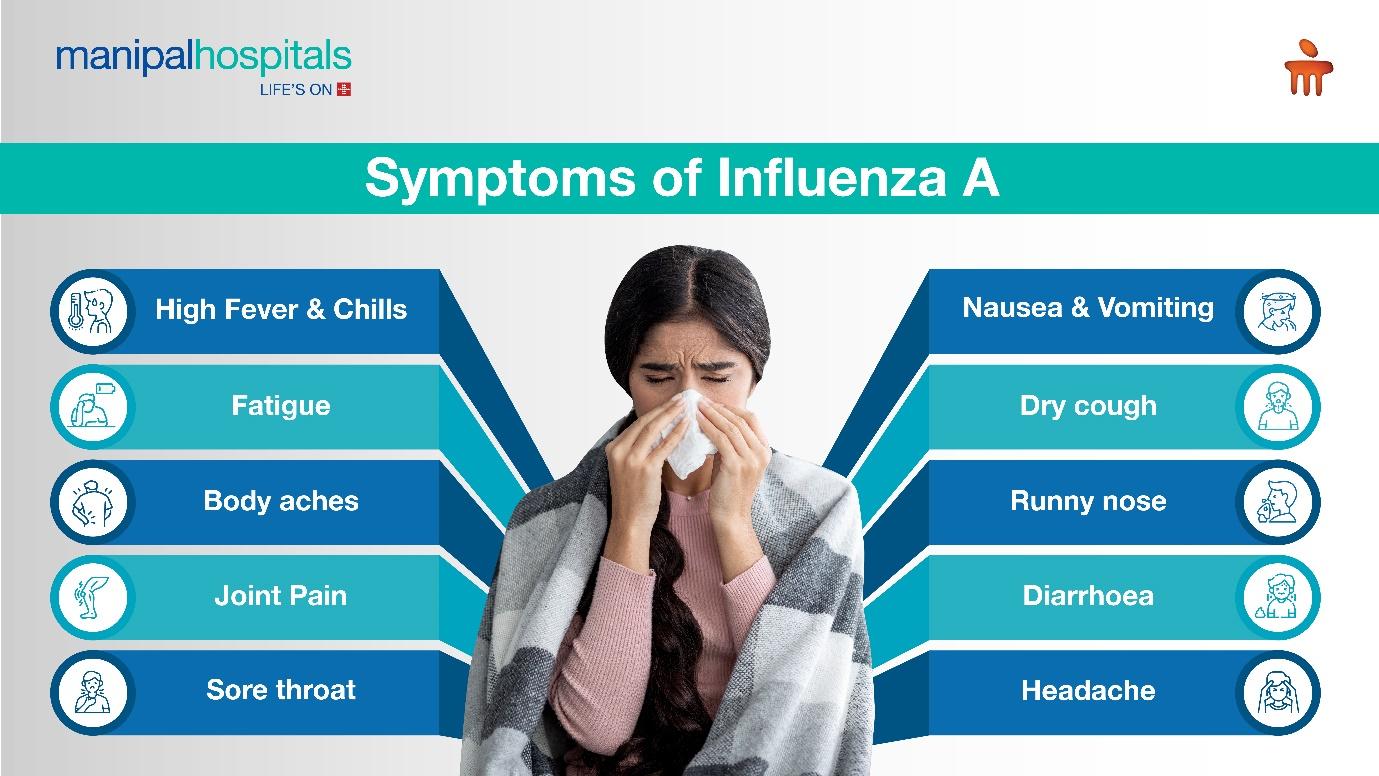
Influenza A is a highly contagious viral infection that significantly impacts both adults and children. This virus, commonly known as the flu, causes severe respiratory illness, leading to hospitalisations and even deaths. The number is particularly high among vulnerable populations such as young children, the elderly, and those with pre-existing health conditions.
According to recent data from the Indian Council of Medical Research (ICMR), India experiences seasonal influenza outbreaks, much like other parts of the world. In recent years, the country has reported influenza-related illnesses and hospitalisations. While the exact figures vary from year to year, it's clear that the flu remains a public health concern.
Vaccination against influenza has proven to be an effective measure in reducing the incidence of the disease and its complications. It offers protection to individuals and helps control the spread of the virus.
Synopsis
What are the symptoms of influenza A?

Symptoms of influenza A typically appear two to three days after being infected with the virus. Some of them are listed below:
- High Fever & Chills
- Fatigue
- Mild to severe body aches
- Joint Pain
- Sore throat
- Headache
- Dry cough
- Runny nose
- Diarrhoea
- Nausea and Vomiting
What is Influenza A?
Influenza A is a contagious respiratory illness caused by an influenza A virus. It spreads rapidly and can lead to a range of symptoms, from mild to severe complications. Influenza A is a subtype of the influenza virus that primarily infects birds and mammals. It is one of the three types of influenza viruses, the other two being influenza B and influenza C. Among these, influenza A is known for its ability to cause pandemics due to its high mutation rate and ability to jump species. The virus is characterised by its surface proteins, hemagglutinin (H) and neuraminidase (N), which are used to classify the virus into different subtypes, such as H1N1 and H3N2.
How does influenza spread?
Direct contact: Direct contact with an infected person, such as shaking hands, can also result in transmission. It is important to note that influenza A can be transmitted before symptoms appear and continue to be contagious for several days after symptoms begin.
Indirect contact: Influenza A primarily spreads through droplets released when an infected person coughs or sneezes. Those around them can inhale these droplets, causing an infection. The virus can also spread by touching surfaces contaminated with these droplets and then touching the face, particularly the mouth, nose, or eyes.
Types of Influenza A
Influenza A viruses are divided into subtypes based on their hemagglutinin and neuraminidase proteins. There are some types of these subtypes that can infect animals and then spread to humans. Notable types include:
-
Bird Flu (Avian Influenza): Caused by various strains of influenza A virus, bird flu. It primarily affects birds but can infect humans through direct or indirect contact with infected birds. Strains such as H5N1 and H7N9 have caused significant outbreaks in the past.
-
Swine Flu (H1N1): This subtype originally infected pigs but has adapted to infect humans. The H1N1 pandemic in 2009 highlighted the virus's ability to spread rapidly among people, causing widespread illness.
-
H3N2: Another subtype that has caused significant seasonal outbreaks in humans. It is known for its high mutation rate. It often leads to changes in the virus, making it challenging to develop effective vaccines.
These subtypes, along with other less common strains, contribute to the complexity and variability of influenza A infections.
Treating Influenza A
Influenza is a viral infection, and antibiotics don't work against it. In order to prevent complications and relieve symptoms, treatment focuses on easing symptoms. Over-the-counter medications can help manage fever, body aches, and congestion. If your symptoms are severe or if you're at high risk for complications, it's essential to seek medical attention.
When to Get the Flu Vaccine?
The best time to get the flu vaccine is before the flu season begins. However, it’s beneficial to get vaccinated even later in the season as it takes about two weeks for the vaccine to provide protection. The flu vaccine composition is updated annually to match the circulating influenza viruses.
In India, the vaccine is especially crucial for healthcare workers, children, elderly individuals, pregnant women, and those with chronic health conditions. The vaccine protects individuals and helps create herd immunity, reducing the overall spread of the virus in the community.
Influenza A is a contagious respiratory illness that can cause significant illness. While it’s difficult to completely avoid the flu, vaccination is the most effective way to protect yourself and others. By understanding how the virus spreads and taking preventive measures, you can help reduce the risk of infection.
Need more information?
If you have further questions about influenza A, its symptoms, or prevention, consult with a healthcare professional at Manipal Hospitals, Vijayawada. They can provide personalised advice based on your health condition and risk factors.
FAQ's
Most healthy individuals recover from influenza A within about a week. However, some individuals may continue to experience persistent symptoms for several weeks.
No, influenza A is different from the common cold. It typically causes more severe symptoms and can lead to complications.
People at high risk for influenza A complications include young children, older adults, pregnant women, and individuals with chronic health conditions like asthma, heart disease, or diabetes.
The most effective way to prevent influenza A is by getting the flu vaccine annually. Good hygiene practices, like frequent handwashing and covering your mouth and nose when coughing or sneezing, also help.
Yes, the flu vaccine is safe and effective. It has been used for many years and is recommended for everyone aged six months and older.



















 4 Min Read
4 Min Read



.png)










